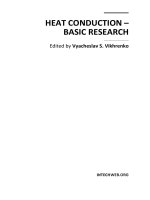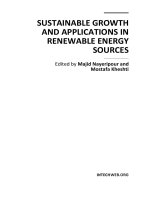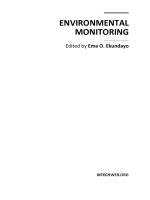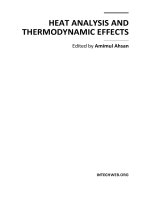Adaptive Filtering Part 1 ppt
Bạn đang xem bản rút gọn của tài liệu. Xem và tải ngay bản đầy đủ của tài liệu tại đây (930.91 KB, 30 trang )
ADAPTIVE FILTERING
Edited by Lino García Morales
Adaptive Filtering
Edited by Lino García Morales
Published by InTech
Janeza Trdine 9, 51000 Rijeka, Croatia
Copyright © 2011 InTech
All chapters are Open Access articles distributed under the Creative Commons
Non Commercial Share Alike Attribution 3.0 license, which permits to copy,
distribute, transmit, and adapt the work in any medium, so long as the original
work is properly cited. After this work has been published by InTech, authors
have the right to republish it, in whole or part, in any publication of which they
are the author, and to make other personal use of the work. Any republication,
referencing or personal use of the work must explicitly identify the original source.
Statements and opinions expressed in the chapters are these of the individual contributors
and not necessarily those of the editors or publisher. No responsibility is accepted
for the accuracy of information contained in the published articles. The publisher
assumes no responsibility for any damage or injury to persons or property arising out
of the use of any materials, instructions, methods or ideas contained in the book.
Publishing Process Manager Petra Zobic
Technical Editor Teodora Smiljanic
Cover Designer Jan Hyrat
Image Copyright Designus, 2010. Used under license from Shutterstock.com
First published July, 2011
Printed in Croatia
A free online edition of this book is available at www.intechopen.com
Additional hard copies can be obtained from
Adaptive Filtering, Edited by Lino García Morales
p. cm.
ISBN 978-953-307-158-9
free online editions of InTech
Books and Journals can be found at
www.intechopen.com
Contents
Preface IX
Part 1 Fundamentals, Convergence, Performance 1
Chapter 1 Convergence Evaluation of a Random
Step-Size NLMS Adaptive Algorithm in
System Identification and Channel Equalization 3
Shihab Jimaa
Chapter 2 Steady-State Performance Analyses of Adaptive Filters 19
Bin Lin and Rongxi He
Chapter 3 The Ultra High Speed LMS Algorithm
Implemented on Parallel Architecture
Suitable for Multidimensional Adaptive Filtering 47
Marwan Jaber
Chapter 4 An LMS Adaptive Filter Using
Distributed Arithmetic - Algorithms and Architectures 89
Kyo Takahashi, Naoki Honma and Yoshitaka Tsunekawa
Part 2 Complex Structures, Applications and Algorithms 107
Chapter 5 Adaptive Filtering Using Subband Processing:
Application to Background Noise Cancellation 109
Ali O. Abid Noor, Salina Abdul Samad and Aini Hussain
Chapter 6 Hirschman Optimal
Transform (HOT) DFT Block LMS Algorithm 135
Osama Alkhouli, Victor DeBrunner and Joseph Havlicek
Chapter 7 Real-Time Noise Cancelling Approach
on Innovations-Based Whitening Application
to Adaptive FIR RLS in Beamforming Structure 153
Jinsoo Jeong
VI Contents
Chapter 8 Adaptive Fuzzy Neural Filtering for Decision
Feedback Equalization and Multi-Antenna Systems 169
Yao-Jen Chang and Chia-Lu Ho
Chapter 9 A Stereo Acoustic Echo
Canceller Using Cross-Channel Correlation 195
Shigenobu Minami
Chapter 10 EEG-fMRI Fusion:
Adaptations of the Kalman Filter for Solving a
High-Dimensional Spatio-Temporal Inverse Problem 233
Thomas Deneux
Chapter 11 Adaptive-FRESH Filtering 259
Omar A. Yeste Ojeda and Jesús Grajal
Chapter 12 Transient Analysis of a
Combination of Two Adaptive Filters 297
Tõnu Trump
Chapter 13 Adaptive Harmonic IIR Notch
Filters for Frequency Estimation and Tracking 313
Li Tan, Jean Jiang and Liangmo Wang
Chapter 14 Echo Cancellation for Hands-Free Systems 333
Artur Ferreira and Paulo Marques
Chapter 15 Adaptive Heterodyne Filters 359
Michael A. Soderstrand
Preface
A digital filter is a structure that transforms sequences of numbers to others from its
input to its output (signals) and models thus the behavior of a real system. The model
or transfer function is a simplified mathematical representation of the system. The
structure of the filter consists of a few elements: delays, multipliers, adders and, less
often, functions whose magnitude, combination and number determine its
characteristics. An adaptive filter, however, is able to self-adjust the parameters of
such elements in time (the coefficients of the multipliers for example) according to
certain algorithm and thus the relationship between the input and output sequences to
adapt itself to the changes of the complex system that represents. This update takes
place, usually, by minimizing a cost function in an iterative scheme.
Digital adaptive filters are, therefore, very popular in any implementation of signal
processing where the system modelled and/or the input signals are time-variants; such
as the echo cancellation, active noise control, blind channel equalization, etc.,
corresponding to problems of system identification, inverse modeling, prediction,
interference cancellation, etc.
Any design of an adaptive filter focuses its attention on some of its components:
structure (transversal, recursive, lattice, systolic array, non-linear, transformed
domain, etc.), cost function (mean square error, least squares), coefficient update
algorithm (no memory, block, gradient, etc.); to get certain benefits: robustness,
speed of convergence, misalignment, tracking capacity, computational complexity,
delay, etc.
This book is composed of 15 motivating chapters written by researchers and
professionals that design, develop and analyze different combinations or variations of
the components of the adaptive filter and apply them to different areas of knowledge.
The first part of the book is devoted to the adaptive filtering fundamentals and
evaluation of their performances while the second part presents structures and
complex algorithms in specific applications.
This information is very interesting not only for all those who work with
technologies based on adaptive filtering but also for teachers and professionals
X Preface
interested in the digital signal processing in general and in how to deal with the
complexity of real systems in particular: non-linear, time-variants, continuous, and
unknown.
Lino García Morales
Audiovisual Engineering and Communication Department
Polytechnic University of Madrid
Spain
Part 1
Fundamentals, Convergence, Performance
1
Convergence Evaluation of a Random
Step-Size NLMS Adaptive Algorithm in
System Identification and Channel Equalization
Shihab Jimaa
Khalifa University of Science, Technology and Research (KUSTAR)
Faculty of Engineering, Dept. of Communications Engineering
Sharjah Campus, Sharjah
United Arab Emirates
1. Introduction
Adaptive filtering algorithms have been widely applied to solve many problems in digital
communication systems [1- 3]. So far, the Least Mean Square (LMS) and its normalized
version (NLMS) adaptive algorithms have been the most commonly adopted approaches
owing to the clarity of the mean-square-error cost function in terms of statistical concept and
the simplicity for computation. It is known that the NLMS algorithm gives better
convergence characteristics than the LMS because it uses a variable step-size parameter in
which the variation is achieved due to the division, at each iteration, of the fixed step size by
the input power. However, a critical issue associated with both algorithms is the choice of
the step-size parameter that is the trade-off between the steady-state misadjustment and the
speed of adaptation. Recent studies have thus presented the idea of variable step-size NLMS
algorithm to remedy this issue [4-7]. Also, many other adaptive algorithms [8, 9] have been
defined and studied to improve the adaptation performance. In this work, the proposed
approach of randomizing the NLMS algorithm’s step-size has been introduced in the
adaptation process of both channel equalisation and system identification, and tested over a
defined communication channels. The proposed random step-size approach yields an
algorithm with good convergence rate and steady state stability.
The objective of this chapter is analyzing and comparing the proposed random step-size
NLMS and the standard NLMS algorithms that were implemented in the adaptation process
of two fundamental applications of adaptive filters, namely adaptive channel equalization
and adaptive system identification. In particular, we focus our attention on the behavior of
Mean Square Error (MSE) of the proposed and the standard NLMS algorithms in the two
mentioned applications. From the MSE performances we can determine the speed of
convergence and the steady state noise floor level. The key idea in this chapter is that a new
and simple approach to adjust the step-size (μ) of the standard NLMS adaptive algorithm
has been implemented and tested. The value of μ is totally controlled by the use of a
Pseudorandom Noise (PRN) uniform distribution that is defined by values from 0 to 1.
Randomizing the step-size eliminates much of the trade-off between residual error and
convergence speed compared with the fixed step-size. In this case, the adaptive filter will
Adaptive Filtering
4
change its coefficients according to the NLMS algorithm in which its step-size is controlled
by the PRN to pseudo randomize the step size. Also this chapter covers the most popular
advances in adaptive filtering which include adaptive algorithms, adaptive channel
equalization, and adaptive system identification.
In this chapter, the concept of using random step-size approach in the adaptation process of
the NLMS adaptive algorithm will be introduced and investigated. The investigation
includes calculating and plotting the MSE performance of the proposed algorithm in system
identification and channel equalization and compares the computer simulation results with
that of the standard NLMS algorithm.
The organization of this chapter is as follows: In Section 2 an overview of adaptive filters
and their applications is demonstrated. Section 3 describes the standard NLMS and the
proposed random step size NLMS algorithms. In Sections 4 the performance analysis of
adaptive channel equalization and adaptive system identification are given. Finally the
conclusion and the list of references are given in Sections 5 and 6, respectively.
2. Overview of adaptive filters and applications
An adaptive filter generally consists of two distinct parts: a filter, whose structure is
designed to perform a desired processing function, and an adaptive algorithm for adjusting
the coefficients of that filter. The ability of an adaptive filter to operate satisfactory in an
unknown environment and track time variations of input statistics make the adaptive filter a
powerful device for signal processing and control applications [1].
Adaptive filters are self learn. As the signal into the filter continues, the adaptive filter
coefficients adjust themselves to achieve the desired result, such as identifying an unknown
filter or cancelling noise in the input signal. Figure 1 represents the adaptive filter, comprising
the adaptive filter and the adaptive weight control mechanism. An adaptive Finite Impulse
Response (FIR) filter or Infinite Impulse Response (IIR) filter designs itself based on the
characteristics of the input signal to the filter and a signal which represent the desired behavior
of the filter on its input. Designing the filter does not require any other frequency response
information or specification. To define the self learning process the filter uses, you select the
adaptive algorithm used to reduce the error between the output signal y(k) and the desired
signal d(k). When the least mean square performance criteria for e(k) has achieved its minimum
value through the iterations of the adapting algorithm, the adaptive filter is finished and its
coefficients have converged to a solution. Now the output from the adaptive filter matches
closely the desired signal d(k). When the input data characteristics changes, sometimes called
the filter environment, the filter adapts to the new environment by generating a new set of
coefficients for the new data. Notice that when e(k) goes to zero and remains there you achieve
perfect adaptation; the ideal result but not likely in the real world.
The ability of an adaptive filter to operate satisfactorily in an unknown environment and
track time variations of input statistics make the adaptive filter a powerful device for signal
processing and control applications [12]. In fact, adaptive filters have been successfully
applied in such diverse fields as communications, radar, sonar, seismology, and biomedical
engineering. Although these applications are quite different in nature, however, they have
one basic common aspect: an input vector and a desired response are used to compute an
estimation error, which is in turn used to control the values of a set of adjustable filter
coefficients. The fundamental difference between the various applications of adaptive
filtering arises in the way in which the desired response is extract.
Convergence Evaluation of a Random Step-Size
NLMS Adaptive Algorithm in System Identification and Channel Equalization
5
In many applications requiring filtering, the necessary frequency response may not be
known beforehand, or it may vary with time. (for example; suppression of engine
harmonics in a car stereo). In such applications, an adaptive filter which can automatically
design itself and which can track system variations in time is extremely useful. Adaptive
filters are used extensively in a wide variety of applications, particularly in
telecommunications. Despite that adaptive filters have been successfully applied in many
communications and signal processing fields including adaptive system identification,
adaptive channel equalization, adaptive interference (Noise) cancellation, and adaptive
echo cancellation, the focus here is on their applications in adaptive channel equalisation
and adaptive system identification.
3. Adaptive algorithms
Adaptive filter algorithms have been used in many signal processing applications [1]. One
of the adaptive filter algorithms is the normalized least mean square (NLMS), which is the
most popular one because it is very simple but robust. NLMS is better than LMS because the
weight vector of NLMS can change automatically, while that of LMS cannot [2]. A critical
issue associated with all algorithms is the choice of the step-size parameter that is the trade-
off between the steady-state misadjustment and the speed of adaptation. A recent study has
presented the idea of variable step-size LMS algorithm to remedy this issue [4].
Nevertheless, many other adaptive algorithms based upon non-mean-square cost function
can also be defined to improve the adaptation performance. For example, the use of the
error to the power Four has been investigated [8] and the Least-Mean-Fourth adaptive
algorithm (LMF) results.
Also, the use of the switching algorithm in adaptive channel
equalization has also been studied [9].
General targets of an adaptive filter are rate of convergence and misadjustment. The fast rate
of convergence allows the algorithm to adapt rapidly to a stationary environment of
unknown statistics, but quantitative measure by which the final value of mean-square error
(MSE) is averaged over an ensemble of adaptive filters, deviates from the minimum MSE
more severely as the rate of convergence becomes faster, which means that their trade-off
problem exists.
3.1 NLMS algorithm
The least mean square (LMS) algorithm has been widely used for adaptive filters due to its
simplicity and numerical robustness. On the other hand, NLMS algorithm is known that it
gives better convergence characteristics than the LMS, because the NLMS uses a variable
step-size parameter in which, in each iteration, a step-size fixed parameter is divided by the
input power. Depending on the value of the fixed step-size parameter, however, the LMS
and NLMS algorithms result in a trade-off between the convergence speed and the mean
square error (MSE) after convergence [5].
3.1.1 Adaptive filter
A general form of the adaptive filter is shown in Figure 1, where an input signal u(n)
produces an output signal y(n), then the output signal y(n) is subtracted from the desired
response d(n) to produce an error signal e(n). The input signal u(n) and error signal e(n) are
combined together into an adaptive weight-control mechanism. The weight controller
Adaptive Filtering
6
applies a weight adjustment to the transversal filter so as to minimize MSE value [11]. This
process is repeated for a number of iterations until the filter reaches to a steady-state. In
summary, the purpose of the adaptive system is to filter the input signal u(n) so that it
resembles the desired signal input d(n). The filter could be any type but the most widely
used is the N tap FIR filter because of its simplicity and stability.
Fig. 1. Block diagram of adaptive transversal filter
3.1.2 Algorithm’s operation
The weight vector of an adaptive filter should be changed in a minimal manner, subject to a
constraint imposed on the updated filter’s output. The NLMS adaptive filter is a
manifestation of the principal of minimal disturbance from one iteration to the next [10]. To
describe the meaning of NLMS as an equation, let w(n) be the old weight vector of the filter
at iteration n and w(n+1) is its updated weight vector at iteration n+1. We may then
formulate the criterion for designing the NLMS filter as that of constrained optimization: the
input vector u(n) and desired response d(n) determine the updated tap-weight vector w(n+1)
so as to minimize the squared Euclidean norm of the change as:
(1)(1)()wn wn wn
δ
+= +−
(1)
Subject to the constraint
() ( 1)()
H
dn w n un=+
(2)
The method of the lagrange multiplier is used to solve this problem as:
1
(1)() ()
2
wn wn un
λ
+= +
(3)
The unknown multiplier, λ, can be obtained by substituting (3) into (2):
2
2
()
()
en
un
λ
=
(4)
Transversal Filter
Adaptive Weight
Control Mechanism
u(n)
y(n)
e
(
n
)
d(n
Convergence Evaluation of a Random Step-Size
NLMS Adaptive Algorithm in System Identification and Channel Equalization
7
Where e(n) is the error signal and is given by:
() () ()()
H
en dn w nun=− (5)
Then, combining (3) and (4) to formulate the optimal value of the incremental change,
δw(n+1), we obtain:
2
(1)() ()()
()
wn wn unen
un
μ
+− =
(6)
Equation (6) can be written as:
2
(1)() ()()
()
wn wn unen
un
μ
α
+= +
+
(7)
Where the constant
α
is added to the denominator to avoid that w(n+1) cannot be bounded
when the tap-input vector u(n) is too small.
3.1.3 Step-size
The stability of the NLMS algorithm depends on the value of its step-size, and thus its
optimization criterion should be found [12]. The desired response has been set as follows:
() ()() ()
H
dn w nun vn=+ (8)
Where v(n) is an unknown disturbance. An estimate of the unknown parameter w is
calculated from the tap-weight vector w(n). The weight-error vector is given below:
() ()nwwn
ε
=− (9)
Substituting (9) into (7) yields:
2
(1)() ()()
()
nn unen
un
μ
εε
+= −
(10)
To study the stability performance of adaptive filters, the mean-square deviation may be
identified [11].
2
() [()]nE n
ξε
=
(11)
Where E denotes expectation. Substituting (10) into (11) yields:
2
2
22
()
()()
(1)() 2 Re
() ()
u
en
nen
nnE E
un un
ξξμ μ
+− = −
(12)
where
()
u
n is the undisturbed error signal defined by:
() ()()
H
u
nnun
ε
= (13)
The bounded range of the normalized step-size parameter can be found from (12) as:
Adaptive Filtering
8
{
}
2
22
Re ()()/ ()
02
() / ()
u
Enenun
Een un
μ
<<
(14)
For the case of real-valued data, the following equation can be used:
2
2
() () ()
u
EnEun n
ξ
=
(15)
Substituting (15) into (14) yields:
2
2
() ()
02
()
Eun n
Een
ξ
μ
<<
(16)
or
02
o
p
t
μμ
<< (17)
where
2
()Een
is the estimation of the error signal power,
2
()Eun
is the estimation of
the input signal power,
()n
ξ
is the estimation of the mean-square deviation, and
o
p
t
μ
is the
optimal step-size parameter.
3.2 The random step-size algorithm
Using the proposed idea of randomizing the step size, the step-size for the NLMS algorithm
is changed into a variable one, where the fixed step size is multiplied by PN (pseudo
random number generator) being a selection from random numbers of uniform distribution
[0 1] at each iteration time. Formulating the Pseudo-random NLMS algorithm results:
2
[]
[1][]()()
|| [ ]||
PN n
wn wn enun
un
μ
α
+= +
+
(18)
Where w(n) is the previous weight of the filter and w(n+1) is the new weight.
The step-size µ directly affects how quickly the adaptive filter will converge toward the
unknown system. If µ is very small, then the coefficients change only a small amount at each
update, and the filter converges slowly. With a larger step-size, more gradient information is
included in each update, and the filter converges more quickly; however, when the step-size
is too large, the coefficients may change too quickly and the filter will diverge. (It is possible
in some cases to determine analytically the largest value of µ ensuring convergence). In
summary, within that margin given in (17), the larger
μ
the faster the convergence rate is but
less stability around the minimum value. On the other hand, the smaller
μ
the slower the
convergence rate but will be more stable around the optimum value.
4. Performance analysis
4.1 Adaptive channel equalization
Adaptive channel equalization in digital communication systems is perhaps the most
heavily exploited area of application for adaptive filtering algorithms. Adaptive filtering
Convergence Evaluation of a Random Step-Size
NLMS Adaptive Algorithm in System Identification and Channel Equalization
9
algorithms have been widely applied to solve the problem of channel equalization in digital
communication systems. This is because, firstly, the adaptation of tap weights of an
equalizer is necessary to perform channel equalization tasks successfully and secondly, the
development of an adaptive algorithm that allows fast weight modification, while
improving the estimation performance of the equalizer, will enhance the capability of such
equalization systems in real applications.
4.1.1 System model
The block diagram of the considered system is shown in Figure 2 below:
Fig. 2. The block diagram of the considered system
The input signal is Binary phase shift keying which has two phases (0 and π) so the signal is
limited between 1 and -1. The general equation for a sum of weighted time delayed
Telephone channel impulse responses can be written as
H(z) = h
0
+h
1
z
-1
+h
2
z
-2
+….h
n
z
-n
(19)
Two types of channels are considered here, the minimum phase (CH-1) and the non-
minimum phase (CH-2) channels, which are given, respectively, below:
H(z) = 1.0 + 0.5z
-1
(20)
H(z) = 0.5 + z
-1
(21)
The discrete time model for the adaptive channel equalization considered in this paper is
depicted in Figure 3.
Fig. 3. The block diagram of the adaptive channel equalization
Signal
Input Signal
AWGN
Telephone
Channel
Equalizer
+
Slicer
Output
Adaptive Filter
Adaptive
Algorithm
u(n)
y(n)
e
(
n
)
d
(n
)
Adaptive Filtering
10
In a transversal adaptive filter, the input vector U
n
and the weight vector W
n
at the time of
n
th
iteration are defined as follows:
11
[, , , ]
T
nnn nM
Uuu u
−−+
= (22)
01 1
[ , , , ]
T
nM
Wwww
−
= (23)
Where u
n
is the filter input and w
i
, (i=0, 1, …, M-1) is the weight vector which corresponds
to the filter length. The filter output is obtained as follows:
T
nnn
y
WU= (24)
The error signal e(k), involved in the adaptive process, is defined by
e(k) = d (k) – y (k) (25)
= d (k) - w
H
(k) u (k) (26)
Where w(k) is the tap-weight vector of the adaptive filter assumed to have a transversal
structure.
4.2 Adaptive system identification
This section introduces adaptive filters through the application of system identification
using the NLMS and the random step-size NLMS algorithms. The adaptive filter adjusts its
coefficients to minimize the mean-square error between its output and that of an unknown
system. The objective is to change (adapt) the coefficients of an FIR filter to match as closely
as possible the response of an unknown system.
4.2.1 System model
Consider the system identification problem illustrated in Figure 4. The Figure shows the
discrete time model for the FIR system identification. One common application is to use
adaptive filters to identify an unknown system, such as the response of an unknown
communications channel. An unknown FIR system with N-point impulse response vector
w(n) has an input sequence {u(n)} and an output sequence {d(n)}. The input signal is binary
phase shift keying (BPSK) which has two phases (0 andπ) so the signal is limited between 1
and -1. The general formula for a sum of weighted time delayed channel impulse response
can be written as:
H(z) = h
0
+h
1
z
-1
+h
2
z
-2
+….h
n
z
-n
(27)
The desired response d(n), providing a frame of reference for the adaptive filter, is defined
by:
d(n) = W
H
(n) U(n) + v(n) (28)
Where U(n) is the input vector, which is common to both the unknown system and the
adaptive filter and v(n) is the Additive White Gaussian Noise (AWGN) with zero mean and
variance σ
2
. First the error signal, e (n), is computed which measures the difference between
Convergence Evaluation of a Random Step-Size
NLMS Adaptive Algorithm in System Identification and Channel Equalization
11
the output of the adaptive filter and the output of the unknown system. On the basis of
this measure, the adaptive filter will change its coefficients in an attempt to reduce the
error.
Hence the error signal, e(n), involved in the adaptive process, is defined by:
e(n) = d(n) – y(n) (29)
= W
H
(n) U(n) + v(n) - W
^H
(n) U(n) (30)
where W^(n) is the tap-weight vector of the adaptive filter assumed to have a transversal
structure.
Fig. 4. System identification model using linear transversal adaptive filter
Clearly, when e(n) is very small, the adaptive filter response is close to the response of the
unknown system. Application of the Wiener filter to this problem involves constructing
an estimate y(n) of the observed output d(n) by passing the observed input sequence u(n)
through a system modeling filter with impulse response vector w(n). The impulse
response of the system model is chosen to minimize the MSE. It is assumed that
the adaptive filter has the same number of taps as the unknown system represented by
w(n).
4.3 Computer simulation results
4.3.1 Adaptive channel equalization
This section presents the computer simulations results of the performance of the non-linear
transversal equalizer adapted by NLMS algorithm and the proposed pseudo-randomized
NLMS algorithm [13]. The system was tested over both minimum phase and non-minimum
phase channels, which are defined, respectively, as follows:
H
1
(z) = 1.0 + 0.5z
-1
(31)
H
2
(z) = 0.5 + z
-1
(32)
The digital signal transmitted through the channel was bipolar BPSK with values of ± 1
and the channel was corrupted by AWGN with SNR = 30dB. The order of the filter was
v(n)
e(n)
d(n)
w(n)
w
^
(n)
u(n)
y(n)
Σ
Σ
Adaptive Filtering
12
set to 12 for both minimum phase, H
1
(z), and non-minimum phase, H
2
(z), channels.
The step size for the NLMS algorithm was chosen from (0.01) to (0.1) and the number of
transmitted bits equals to 2500 bits. The comparison between the two algorithms,
the standard NLMS and the pseudo random step size NLMS, is done by first choosing
the best step size that gives fast convergence and then uses this step size for the
comparison.
Figure 5, shown below, shows that the step size with a value of 0.05 gives the
fast convergence rate over the minimum phase channel (CH-1) while over the
non-minimum phase channel (CH-2) the step size with a value of 0.01 gives the fast
convergence rate. The comparison also looks at the effects of decreasing the SNR from 25
dB to 5 dB. While Figures 6 – 8, shown below, show the performances of the mean square
error against the number of iterations for various values of signal-to-noise ratios using
non-linear transversal equalizer over the minimum phase channel. From these figures it is
clear that the speed of convergence has approximately the same convergence rate for both
algorithms but the ground noise floor level decreases when the SNR decreases in the case
of using the random step-size NLMS algorithm. The same conclusion has been noticed in
the case of using the non-minimum phase channel that defined in (32) above. This is due
to that the step-size parameter of the proposed random NLMS algorithm is designed
based on utilizing the random distribution which made the error sequence accelerates the
level of the noise floor to a much lower value compared to that of the standard NLMS
algorithm with a fixed step-size value. Results for CH-2 are not included here due to
space limitation.
Fig. 5. MSE performances of the NLMS for various step-sizes over CH-1
Convergence Evaluation of a Random Step-Size
NLMS Adaptive Algorithm in System Identification and Channel Equalization
13
Fig. 6. MSE performances of the two algorithms for SNR=15dB over CH-1
Fig. 7. MSE performances of the two algorithms for SNR=10 dB over CH-1









